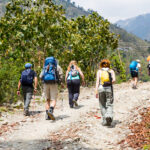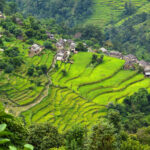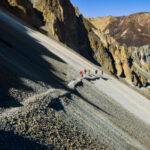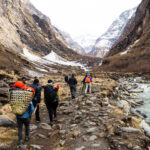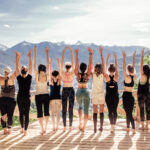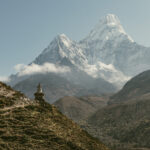Packing for Nepal: What to bring to the Himalaya?
Nepal, nestled in the lap of the mighty Himalayas, is a land of diverse landscapes and breathtaking beauty. From towering peaks to lush valleys, this country offers a wide range of experiences for travelers. As you prepare for your journey to Nepal, it is essential to understand the country’s varied weather patterns and the impact of altitude on climate. In this comprehensive guide, we will explore Nepal’s seasons, climate zones, and provide a list of 15 necessary items to pack for your adventure in the Himalaya region. You’ll know exactly what to expect, and from 15+ years of experience, the packing for Nepal will be clear.
Understanding Nepal’s Seasons and Climate Zones
Nepal experiences four distinct seasons: spring, summer, autumn, and winter. Each season brings its own unique weather conditions, and understanding these seasons will help you pack accordingly. We hear people surprised when we tell them how hot it gets even in Pokhara – everybody associating the Himalayan mountain country with snow and ice, not expecting the almost tropical weather there. Another reason why packing for Nepal is so difficult, but don’t worry: You have access to buy everything in Thamel or Lakeside.
1. Spring (March to May):
Spring in Nepal is characterized by mild temperatures, blooming flowers, and clear skies. Daytime temperatures range from 20°C to 30°C (68°F to 86°F) in the lower regions, making it comfortable for outdoor activities. However, as you gain altitude, temperatures drop, and nights can be chilly. It is advisable to pack layers, including lightweight clothing for warmer days and a warm jacket or fleece for cooler evenings.
2. Summer (June to August):
Summer in Nepal is monsoon season, with heavy rainfall and high humidity. The lower regions experience hot and humid weather, with temperatures ranging from 25°C to 35°C (77°F to 95°F). It is essential to pack lightweight, breathable clothing that dries quickly and rain gear to stay dry during sudden showers. In higher-altitude regions, such as the Himalayas, temperatures are cooler, but rainfall is still common.
3. Autumn (September to November):
Autumn is the most popular season to visit Nepal, offering clear skies, moderate temperatures, and stunning mountain views. Days are warm and pleasant, with temperatures ranging from 15°C to 25°C (59°F to 77°F) in the lower regions. As you ascend to higher altitudes, temperatures drop, and nights can be chilly. Pack a mix of light and warm clothing, including a good quality down jacket for colder nights.
4. Winter (December to February):
Winter in Nepal brings colder temperatures, especially in higher-altitude regions. Daytime temperatures in the lower regions range from 10°C to 20°C (50°F to 68°F), but temperatures can drop below freezing at night. In the Himalayas, temperatures can plummet, and snowfall is common. Pack warm clothing, including thermal layers, a heavy jacket, hats, gloves, and sturdy boots to navigate snowy terrains.
Understanding Nepal’s Climate Zones
Nepal, with its diverse topography and varying altitudes, is home to several climate zones and ecosystems, each offering a unique and rich biodiversity. Let’s delve into the different climate zones and the ecosystems they host in Nepal.
1. Tropical Zone (Terai):
The Terai region, located in the southernmost part of Nepal, falls within the tropical zone. This region experiences hot and humid weather, with temperatures soaring up to 40°C (104°F) during the summer. The Terai is characterized by dense forests, wetlands, and grasslands. It is home to an abundance of wildlife, including the endangered Bengal tiger, one-horned rhinoceros, Asian elephant, and various species of deer, birds, and reptiles. National parks such as Chitwan and Bardia protect these ecosystems and offer opportunities for wildlife safaris and bird watching.
2. Subtropical Zone:
Above the Terai lies the subtropical zone, which is characterized by moderate temperatures and a mix of deciduous and evergreen forests. This zone is known for its diverse flora and fauna, including several species of orchids, rhododendrons, monkeys, and bird species. Popular destinations in the subtropical zone include the Kathmandu Valley, Pokhara, and the lower regions of popular trekking routes like the Annapurna Circuit and Langtang Valley.
3. Temperate Zone:
As you ascend further into the mountains, you enter the temperate zone. This zone experiences moderate temperatures, with cooler summers and cold winters. The temperate zone is known for its lush forests of oak, maple, and pine trees. Rhododendron forests, in particular, are a highlight, with vibrant blooms during the spring season. This zone is home to several wildlife species, including the elusive red panda, Himalayan black bear, and various species of deer and birds. The popular trekking regions of Langtang, Helambu, and parts of the Annapurna region fall within the temperate zone.
4. Subalpine Zone:
The subalpine zone is characterized by colder temperatures, and vegetation starts to transition into shrubs, grasses, and mosses. This zone is home to hardy plants such as juniper, dwarf rhododendron, and alpine grasses. As you reach higher altitudes, you’ll encounter breathtaking alpine meadows and pristine lakes. The subalpine zone is where trekkers pass through on their way to popular high-altitude destinations such as Everest Base Camp and the Annapurna Sanctuary.
5. Alpine Zone:
The alpine zone, also known as the high mountain region, is located above the treeline and experiences harsh conditions with extremely low temperatures and strong winds. Vegetation is sparse, consisting mostly of lichens, mosses, and hardy alpine plants. This zone offers spectacular views of snow-capped peaks, glaciers, and high-altitude lakes. Endangered species such as the snow leopard and Himalayan tahr can be found in this zone, along with various species of birds adapted to high-altitude environments.
6. Nival Zone:
The nival zone refers to the permanently snow-covered areas, including glaciers and the highest peaks of the Himalayas. This zone is characterized by extreme cold and limited vegetation. It is a challenging and inhospitable environment, suitable for experienced mountaineers and researchers studying glacial formations and climate change.
These distinct climate zones and ecosystems in Nepal showcase the country’s incredible natural diversity and offer a range of experiences for visitors and the way they need to be packing for Nepal. Whether you’re exploring the lush jungles of the Terai, trekking through the rhododendron forests of the temperate zone, or gazing at the towering peaks in the altitude, Nepal’s landscape is surprisingly diverse. I remember crossing all those zones on my first Annapurna circuit, and it was like I was visiting different worlds. I also remember having a backpack full of things I didn’t need, that’s why you get my exclusive packing list now! Packing for Nepal made easy in 3,2,1…
Packing for Nepal: Essentials for the Himalaya:
1. Clothing:
– Lightweight and breathable shirts, pants, and shorts for warmer days.
– Long-sleeved shirts and pants for protection against the sun and insects. Go for something with merino, it dries fast and keeps you warm.
– Warm jackets, fleece, and thermal layers for cooler temperatures.
– Waterproof and windproof outer shell for protection against rain and snow.
– Sturdy, comfortable hiking boots and extra pairs of socks. Those are your lifeline – make sure they really fit. Also, bring a pair of flip-flops to release your feet on flat terrain.
2. Travel Accessories:
– A well-fitted backpack for trekking and day trips. Make sure you’ve worn it before!
– Hat or cap to shield from the sun.
– Sunglasses with UV protection. Those reflections of ice and snow harm your eyes!
– Travel-sized toiletries and a quick-drying towel.
– High-quality sunscreen and insect repellent.
– Portable water bottle or hydration system. Make sure you bring something to clean your water, either chemical or a UV pen. Nepal doesn’t have the infrastructure to deal with all the plastic as a byproduct of tourism, and we don’t want to contribute to that.
– Travel adapter and portable charger for electronic devices.
3. Trekking Gear (if applicable):
– Trekking poles for stability and support on uneven terrain.
– Sleeping bag suitable for cold temperatures. Really get a good one, you won’t be able to enjoy your trek if you’re cold every night.
– Headlamp or flashlight with spare batteries.
– First aid kit with essential medications and supplies. Ginger is the go for pretty much everything, including altitude sickness.
– Map, compass, or GPS device for navigation. Maps you can buy everywhere, but also get yourself a reliable GPS app.
4. Miscellaneous
– Lightweight, quick-drying travel pants.
– Warm gloves and a beanie for colder weather. Even if it’s warm in Pokhara, you will need it!
– Travel insurance with coverage for outdoor activities. Make sure they cover helicopter rescue.
– Personal identification documents and copies of important documents. Also bring some passport pictures as you will need them for the travel permit.
– Cash in local currency and a money belt for secure storage. You will need to pay your visa in cash.
Packing for Nepal – anything else?
Packing for Nepal’s Himalaya region requires careful consideration of the seasons, climate zones, and your planned activities. Whether you’re trekking through the mountains or exploring cultural sites, having the right clothing, gear, and accessories is crucial. By following this comprehensive packing guide, you’ll be well-prepared to embrace the diverse landscapes and weather conditions that Nepal has to offer. So, pack wisely, embark on your adventure, and create unforgettable memories in the enchanting Himalayas of Nepal. Don’t worry, when you sign up for one of our Yoga and Trekking adventures, we will advise you carefully on what to bring.


